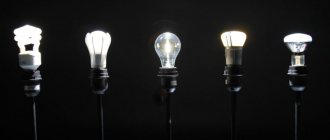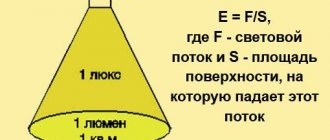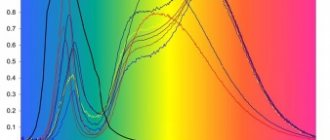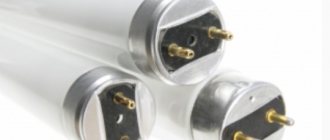Light brightness characteristics
Brightness is the intensity of light emitted from a certain area of an object in a given direction (L=I/S).
Note! We are talking not only about emitted light, but also about reflected light.
Sun brightness
Surfaces with different reflective abilities under the same illumination have different brightness values. This is influenced by the coloring and reflective properties of objects.
This parameter of light emitted by a surface at an angle Ф is equal to the ratio of the beam strength (I) to the area of its projection (S).
Brightness
Neither the denominator nor the numerator of this ratio depends on the distance to the object, so this value is also not determined by it.
If the observed object is at an angle other than 90 degrees, the cosine of this angle is also taken into account in the calculations: L=Ia/(S*cosa).
When calculating the indicator for conventional incandescent lamps, it is taken into account that the projection of their surface has the shape of a circle. And for gas-discharge light sources it is represented by rectangles. For irregularly shaped objects, measurements may capture gaps between surface areas that do not emit light.
Brightness of some objects
On a note! Brightness should not be confused with illuminance, which is determined by the ratio of light density to the area of the illuminated object.
Brightness-lightness
Let me remind you of the basic concepts of physical optics: 1. Light intensity . Luminous intensity is understood as the amount of luminous flux per unit solid angle. The light source is assumed to be a point one. Luminous intensity is measured in candelas (cd). 2. Brightness of (direct or reflected) radiation. If the light source is not a point, we speak of radiant luminance (or surface luminance). Brightness is measured in nits (1nt=1cd/1m2). 3. Illumination . Illumination is the amount of luminous flux incident on a unit surface. Illumination is measured in lux (lx).
In the sensation of color, brightness corresponds to lightness. The brightness of incident or reflected light is the physical basis of the lightness of the corresponding color. Just like brightness - lightness, illumination is an important physical optics concept for color correction.
. Illumination is inversely proportional to the square of the distance to the light source.
Drop in brightness at the first meter and drop in brightness between the first and second meter
The illumination by the sun of objects located at the same angle in relation to the sun's ray is equal, since in the limited space of a given landscape objects are located almost at the same distance from the sun. On the contrary, the illumination of objects in a room decreases extremely quickly as one moves away from the window or lamp.
At the same time, illumination is directly proportional to the cosine of the angle formed by the incident ray and the normal to the surface of the object. It should be borne in mind that, even knowing the brightness of the emitter, it is not easy to calculate the illumination of a given object, since it is necessary to sum up the luminous flux incident on the illuminated area from different points of the light source, taking into account both the intensity of radiation in a given direction and the distance from the area to a given point of the emitter and, finally, the angle of incidence of the light flux on the site. As they say in physics, illumination is an “integral” quantity. No one, of course, makes calculations when performing image correction - the perceived illumination of the subject in the image is achieved by visual control and depends on the qualifications of the color corrector.
It is useful to keep in mind that the human eye reacts to the brightness of the radiation, and not to the amount of light energy, unlike the camera matrix. The magnitude of the effect of light on the eye (the intensity of the sensation of light) does not depend on the time of exposure to light. Once the eye has adjusted to light, we retain a relatively constant impression of brightness. When making corrections, we must take into account that the adaptation of the viewer’s eye in terms of illumination does not occur for each image separately - but mainly depends on the brightness of the illumination of the “viewing” place, which means the light-shadow relationships of the image for viewing in galleries, where the lighting is sufficient low in brightness and diffused - the eye is adapted for perception in low light, when the lightest point in the image is perceived as the lightest and the eye is “ready” to perceive details in the shadow area and “agrees” with the lack of detail in the extreme shadows. When preparing an image for publication in a book (magazine), the external viewing light is quite bright, and the brightest point is the white sheet of paper on which the image is printed. Because of this, the images prepared by photographers in a multi-page publication look like a defect - “veil” and “blackness”. Photographers are now focused on the perception of images from the monitor screen (the lightest is the lightest point of the image and the external illumination of the viewing area is always lower than the “radiation” of the image from the monitor) - these are the conditions of the “gallery”.
An image prepared for comfortable viewing from a monitor or for printing in a “gallery”.
Image in gallery
Image prepared for printing in a publication, album
Are light and color the same thing? Light is radiation. He belongs to space. Color belongs to the object. The sun emits light. The sky glows at dawn, the disk of the moon and the lamp glow. Objects usually do not glow; they are not sources of light. On the other hand, the impression of color is caused precisely by the radiation entering the eye, and, if we ignore the aftereffects of the color stimulus, only by them.
We contrast color with light, not realizing that color is ultimately also radiation, but less bright . If a sheet of white paper is illuminated by a bright beam of light that also covers surrounding objects, we see white. But if you illuminate just one sheet of paper with the same light, tearing it out from its surroundings with a sheaf of light, the sheet will seem to glow, emitting white light. In fact, a sheet of paper in both the first and second cases emits the same stream of light waves reflected from it. We perceive relatively weak radiation as color, strong radiation as light. Light falling on objects around us causes many gradations of tone (lightness). The first reason for differences in tone is the weakening of the light flux in space, the second is the variety of colors of objects, that is, the ability of a substance to absorb the light flux more or less strongly.
The reflected radiation will be brighter and the object will be brighter, the less strongly the substance absorbs the light incident on it. The relationship between the illumination of an object and the brightness of the radiation reflected from it is called “ albedo ” (from album - white). Ideally white reflects and scatters the entire light flux incident on it. The albelo of ideal white is thus equal to one. The albedo of black approaches zero. The albedo of white paper is approximately 0.8. The albedo of titanium white powder is about 0.9. Albedo does not change with changes in lighting and forms the physical basis of what could be called the lightness of an object's color. We see object lightness, and not just remember or know. This is taught by all our subject experience, everyday human practice. If of two objects the light one is in the shadow and the dark one is in the light, we can still, in many cases, correctly answer the question of which of them is lighter in color.
But we see and expect also differences in tone caused by an objective difference in the brightness of the reflected radiation, and this latter is associated not only with the color of objects, but also with different illumination. Some objects are illuminated, while others are cast in shadow. The space is divided by light and shadow. Different planes of an object are illuminated more or less depending on their position relative to the light source. Light and shadow create the shape of an object in an image. And at the same time, coloring (color) is tied to the illumination of the scene - the color must correspond to the illumination and the illumination should not conflict with the color (the expected color of the objects in the scene).
We see continuous transitions of tone from light to shadow and jumps in tone. In all these cases, we are no longer talking about objective lightness, but about tone as the visible brightness of reflected radiation. This also includes gradations of tone associated with space and spatial plans. Let us remember a row of lanterns stretching into the distance.
The distant lights do not light up. Let's remember the smoothing out of tonal differences in distant plans compared to near ones. Throughout this we mean tone as the apparent brightness of the radiation. Lighting not only causes gradations of tone strength, entering into a complex interaction with objective lightness, but also unifies colors by tone, subordinating them to a general tone. The overall tone is a direct consequence of the overall illumination . The overall tone and illumination vary within very large limits, not only depending on what is shown in the image - an open field, a narrow street or a room, not only depending on the weather, time of day, but also on a number of other reasons, for example, on time years, depending on geographic latitude. The actual illumination of the sky by diffuse light at the latitude of St. Petersburg at one o'clock in the afternoon in January is 5 times less than the illumination at the same time of day in June and is equal to the illumination by diffuse light of the sky on a June evening (at 7 o'clock in the evening). Direct sunlight increases illumination on a June afternoon by another 5-6 times. We certainly notice a difference in the overall illumination. A thundercloud has arrived, and we say: “It’s getting dark.” But the eye quickly gets used to the changed illumination. Its specificity is smoothed out.
In a room in daylight, the illumination sufficient for reading a book is approximately 50 times less than the illumination by the “diffuse” light of the sky in January at one o’clock in the afternoon. And indeed, the snow blinds us from the first minutes when we leave the room onto the street. However, we become so accustomed to room lighting that an artist may paint a still life placed on a table in a room with almost the same light colors as a still life placed in a garden in the diffused light of the sky. What can we say about the dark interiors depicted in not at all dark paintings by Adrian van Ostade, about the lighting of candles in Rembrandt’s “Descent from the Cross”? Illumination is a powerful source of tonal unification. It creates a range of lightness of a given piece and the state of nature. It increases and decreases the number of visible lightness, sometimes causing many sharp differences, sometimes leading objects into color indistinguishability. The tonal solution of the image should be entirely dependent on the content of the image, its plot - on the context .
At one time, the physicist Helmholtz, writing about painting, tried to give a simple rule for transforming the tonal range of a real scene into the tonal range of an image, based on the fact that the sensitivity of the eye is inversely proportional to the overall illumination. Helmholtz recommended that artists take each spot of the painting as many times darker than the natural spot, in which the illumination of the picture is less than the total illumination in the depicted natural motif. The relationships in the picture should seem identical to natural relationships. Artists have a greater tonal range at their disposal than the tonal range of offset printing that a color corrector deals with.
When working with an image, it is important to build a balance of light-shadow relationships so that the viewer “believes”. And here another factor comes into play - the audience’s preparedness to perceive the conventions and symbolism of the image. An inexperienced viewer will not understand images that are impressionistic in style - what they see will conflict with their experience of perceiving the image as a “tracing copy” of reality. What is forgiven in a family photo album, what is admired at photo exhibitions and photo sites in a printed multi-page publication usually causes rejection and rejection, but this is already from the field of psychology..
Read the book by N. Volkov Color in painting.
What devices to measure the brightness of light
When inspecting occupational health and safety regulations, brightness meters are used. These include exposure meters and special sensors.
The design of the devices is characterized by the presence of a viewing angle limiter (usually a tube, grille or lens). If their light reception area is rectangular, then there are two angles of coverage at once - one is located horizontally, the other is located vertically.
Instrument coverage angles
Additionally! Professional devices have sighting sights installed as standard.
The sensitivity of the device is directly dependent on the square of its coverage angle. The maximum distance from the brightness meter to the measurement point also depends on its technical characteristics.
Distance from the brightness meter to the measurement object
Note! If the maximum permissible distance is exceeded, foreign objects located in the vicinity of the light source enter the measurement field of the device.
The brightness of an object can be measured in two ways - direct and indirect. In the first case, the device directly measures the maximum and minimum parameters, in the second, the contrasts of lightness and illumination are assessed.
How to measure light brightness correctly
When testing light bulbs and other lighting devices, it is difficult to thoroughly determine their brightness level due to the roundness of their surface. Most often, this indicator is determined for monitors, displays and TV screens.
In order to obtain correct indicators, the following conditions must be met:
- Shield the lens from extraneous light sources. Indoor measurements can be taken in complete darkness.
- No shadow should fall on the measurement object (including from the device and the person taking the brightness readings).
Shadow on a brightness measurement object
- There should be nothing in the sensor's field of view other than the light source being measured.
- At the beginning and end of measurements, the voltage level in the network is checked.
- If there is a natural light source, the ratio of its illumination to this parameter cannot exceed 0.1.
- Measurements are taken under normal weather conditions.
You may be interested in: Formulation and definition of Ohm's law
Measurement procedure
Necessary procedure for measuring brightness level:
- Turn on the brightness meter and set it to measurement mode.
- Place it as close as possible to the light source, perpendicular to the rays (parallel to the surface).
Note! If the surface is hot, the distance to the measurement object should be at least 1 cm.
- When taking readings, the device must be in a static position.
- Take measurements at several points, then calculate the average value.
Monitor brightness measurement points
Light brightness standards
An indicator of over 160,000 candelas per m2 causes discomfort in the eyes and tearing. Therefore, lamp manufacturers increase the area of light sources (light bulb filament) due to large matte shades. This light is more pleasant and safer for the human visual organs, and does not have a negative effect on concentration.
Brightness standards according to GOST R 52870-2007
When measuring this indicator, take into account:
- When adapting to light, this value should be ≥ 10 cd/m2, to shade - no more than 0.01 cd/m2.
- On screens, this parameter for a monochrome image should normally be over 3,000 cd/m2, for a color image – 10,000 cd/m2 (at the same time, for each color more than 1,500 cd/m2).
- When determining this light indicator at different points on the screen, the difference between the maximum and minimum numbers is determined by the ratio of the first value to the second, and the value should be in the range from 0 to 0.7.
- Night brightness levels should be 2–100 times less than daytime ones.
Note! The brightness of monitors in the presence of external lighting is not standardized.
Monitor in ambient light
Light brightness is a very important parameter that affects a person’s vision and performance, and should not be neglected. Thus, for harmless work with the monitor indoors, you can install a brightness control on the device, which will change its indicators by 10–100 times, depending on the time of day and the presence of natural light.
You may be interested in this Definition of plus and minus in electrical engineering
How is the brightness of a monitor and TV screen measured?
What is screen brightness? This is one of the important parameters by which you choose a monitor, laptop and TV. Brightness units characterize the display of white color on the screen under outdoor lighting. The brighter the monitor, the better the image will be visible in strong sunlight; that’s what monitor brightness is. The unit for measuring screen brightness depends on the reflectivity of the monitor’s coating, since under the same illumination, the brightness of different screens may differ. Many people are interested in the question of how the brightness of a monitor, laptop, or TV is measured? So, any brightness is measured in candelas from 1 square meter of screen. Brightness cd/m2 what is it? Previously, candelas were equated to the brightness of a regular paraffin candle. It’s just that you can’t measure screen brightness in candelas, since the larger the screen, the brighter it will illuminate a dark room. Therefore, if the brightness of monitors is measured only in candelas taken from the entire screen area, then screens with a larger diagonal will always have greater brightness than screens with a smaller diagonal. To avoid this incorrect measurement, they began to measure the brightness of the monitor at the rate of 1 square meter. Example.
- A 90 cm diagonal screen will have an area of approximately 0.32 m2.
- A 45 cm diagonal screen will have an area of approximately 0.08 m2.
- In this case, both monitors will have the same brightness of the entire screen, for example 10 candelas.
Then a screen with a diagonal of 90 cm will have a brightness of 31.25 cd/m2, and a screen with a diagonal of 45 cm will have a brightness of 125 cd/m2. Therefore, in terms of brightness, you need to take a screen with a diameter of 45 cm, since during the day everything will be perfectly visible on it, but on a screen with a diagonal of 90 cm, the entire image will fade from the light falling on it. Previously, only CRT monitors were produced. How is the brightness of a CRT monitor screen measured, also in candelas per square meter. Moreover, for CRT monitors, even the most expensive models, the brightness barely reached 250 cd/m2. In what units is brightness measured in modern LCDs, also in candelas per square meter. These modern monitors have much higher brightness and can reach 500 cd/m2.
You can find out the monitor brightness by model at market.yandex.ru
LCD monitors have a backlight with which you can adjust the brightness. Since the screen brightness is adjustable, it therefore has a maximum and minimum value. To work with text, you need to choose monitors with a brightness of 70 to 130 cd/m2. To watch movies and play games, it is recommended to choose monitors with a brightness of over 250 cd/m2. When choosing a monitor, look at how a darkish picture will look on it at maximum and minimum brightness. If you are going to sit with a laptop or tablet on the street, then you need to choose a gadget that has high brightness. If you set the device to high brightness, you will see everything on the screen perfectly even in the sunniest weather. Now you know how display brightness is measured.











